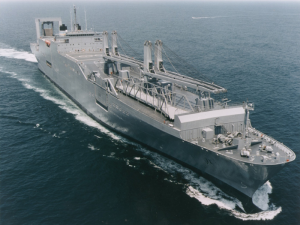America’s reliance upon its merchant marine, ports, shipyards, and maritime industries for both trade and defense has been constant since colonial days. After several decades of continuous decline of its merchant fleet and maritime industrial base, the United States stands at a pivotal crossroads at the beginning of the new millennium.
The U.S. merchant marine — long a symbol of “Yankee” vitality, innovation, and seapower — is in a position to continue to decline and be in jeopardy, as was the case until recent years, or progress further with continued recognition and reliable advances made in partnership with federal policymakers. Nonetheless, the merchant fleet that ruled the waves at the end of World War II is a mere sliver of its former might. Carrying no more than one to two percent of America’s oceanborne foreign trade in 2008, U.S.-flag vessels handle a small fraction of total world seaborne commerce.
This decline is especially troubling for national security reasons. Billions of dollars have been “invested” in government-owned vessels to carry U.S. military equipment and material to overseas contingencies — costly ships that lie idle in peacetime. When called up, these government-owned vessels rely on private U.S. civilian mariners to activate and crew the vessels. In recent years, these reserve ships and their active merchant marine counterparts, manned by highly skilled and motivated U.S. citizen-seafarers, have served the nation well — from Haiti, to Somalia, to the Persian Gulf, to Bosnia and Iraq.
However, a portion of the scarce public resources that have been allocated largely for inactive ships could be more effectively used elsewhere as the United States seeks to define its place as we transition from the post-Cold War world to the Age of Global Terrorism.

 From both economic and national security perspectives, U.S. domestic shipping — the Jones Act trade serving more than 90 percent of the United States and annually carrying nearly one billion tons of cargo on our coastal and inland waterways — is also a critical element of the nation’s intermodal shipping system. The Jones Act stipulates that vessels engaged in the domestic trades must be U.S. owned, built and crewed. The coastwise, domestic ocean, Great Lakes, and inland waterways fleet moves nearly 40 percent of the nation’s domestic freight for less than three percent of the national freight bill. The private investment in domestic shipping is nearly $20 billion, which generates more than $10 billion in annual revenues, and fuels America’s economy while supporting national security needs. The U.S. domestic shipping fleet comprises 5,603 towboats and pushboats, 19,536 dry cargo barges, and 5,405 liquid cargo barges; also included are 1200 supply boats and 123 mobile offshore drilling units (MODUs) currently in U.S. waters serving the U.S. oil and gas industry. Of the nearly 26,000 miles of commercially navigable inland waterways, 11,000 miles are significant for domestic commerce. Non-self-propelled combinations of barges pushed by a single tug dominate the commercial cargo trade on the inland waterways. A highly efficient, environmentally responsible, and safe mode of freight transportation, each barge carries as much cargo as 70 tractor trailer trucks or 16 rail hopper cars — a typical dry cargo tow of 15 barges carries as much freight as 1,050 large semi tractor-trailer trucks or 216 rail cars + 6 locomotives The domestic shipping industry’s vital support to national security needs in crisis, contingency and war continues to be addressed both inside and outside government.
From both economic and national security perspectives, U.S. domestic shipping — the Jones Act trade serving more than 90 percent of the United States and annually carrying nearly one billion tons of cargo on our coastal and inland waterways — is also a critical element of the nation’s intermodal shipping system. The Jones Act stipulates that vessels engaged in the domestic trades must be U.S. owned, built and crewed. The coastwise, domestic ocean, Great Lakes, and inland waterways fleet moves nearly 40 percent of the nation’s domestic freight for less than three percent of the national freight bill. The private investment in domestic shipping is nearly $20 billion, which generates more than $10 billion in annual revenues, and fuels America’s economy while supporting national security needs. The U.S. domestic shipping fleet comprises 5,603 towboats and pushboats, 19,536 dry cargo barges, and 5,405 liquid cargo barges; also included are 1200 supply boats and 123 mobile offshore drilling units (MODUs) currently in U.S. waters serving the U.S. oil and gas industry. Of the nearly 26,000 miles of commercially navigable inland waterways, 11,000 miles are significant for domestic commerce. Non-self-propelled combinations of barges pushed by a single tug dominate the commercial cargo trade on the inland waterways. A highly efficient, environmentally responsible, and safe mode of freight transportation, each barge carries as much cargo as 70 tractor trailer trucks or 16 rail hopper cars — a typical dry cargo tow of 15 barges carries as much freight as 1,050 large semi tractor-trailer trucks or 216 rail cars + 6 locomotives The domestic shipping industry’s vital support to national security needs in crisis, contingency and war continues to be addressed both inside and outside government.